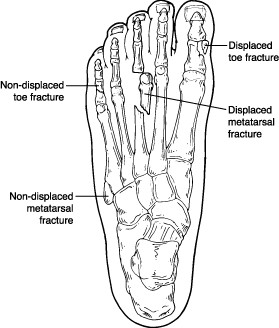What Is a Fracture?
A fracture is a break in the bone. Fractures can be divided into two categories: traumatic fractures and stress fractures.

Stress fractures are tiny, hairline breaks that are usually caused by repetitive stress. Stress fractures often afflict athletes who, for example, too rapidly increase their running mileage. They can also be caused by an abnormal foot structure, deformities, or osteoporosis. Improper footwear may also lead to stress fractures. Stress fractures should not be ignored. They require proper medical attention to heal correctly.
Symptoms of stress fractures include:
- Pain with or after normal activity
- Pain that goes away when resting and then returns when standing or during activity
- “Pinpoint pain” (pain at the site of the fracture) when touched
- Swelling, but no bruising
Consequences of Improper Treatment
Some people say that “the doctor can’t do anything for a broken bone in the foot.” This is usually not true. In fact, if a fractured toe or metatarsal bone is not treated correctly, serious complications may develop. For example:
- A deformity in the bony architecture which may limit the ability to move the foot or cause difficulty in fitting shoes
- Arthritis, which may be caused by a fracture in a joint (the juncture where two bones meet), or may be a result of angular deformities that develop when a displaced fracture is severe or hasn’t been properly corrected
- Chronic pain and deformity
- Non-union, or failure to heal, can lead to subsequent surgery or chronic pain.
Treatment of Metatarsal Fractures
Breaks in the metatarsal bones may be either stress or traumatic fractures. Certain kinds of fractures of the metatarsal bones present unique challenges.
For example, sometimes a fracture of the first metatarsal bone (behind the big toe) can lead to arthritis. Since the big toe is used so frequently and bears more weight than other toes, arthritis in that area can make it painful to walk, bend, or even stand.
Another type of break, called a Jones fracture, occurs at the base of the fifth metatarsal bone (behind the little toe). It is often misdiagnosed as an ankle sprain, and misdiagnosis can have serious consequences since sprains and fractures require different treatments. Your foot and ankle Podiatrist is an expert in correctly identifying these conditions as well as other problems of the foot.
Treatment of metatarsal fractures depends on the type and extent of the fracture, and may include:
- Rest. Sometimes rest is the only treatment needed to promote healing of a stress or traumatic fracture of a metatarsal bone.
- Avoid the offending activity. Because stress fractures result from repetitive stress, it is important to avoid the activity that led to the fracture. Crutches or a wheelchair are sometimes required to offload weight from the foot to give it time to heal.
- Immobilization, casting, or rigid shoe. A stiff-soled shoe or other form of immobilization may be used to protect the fractured bone while it is healing.
- Surgery. Some traumatic fractures of the metatarsal bones require surgery, especially if the break is badly displaced.
- Follow-up care. Your Podiatrist will provide instructions for care following surgical or non-surgical treatment. Physical therapy, exercises and rehabilitation may be included in a schedule for return to normal activities.
